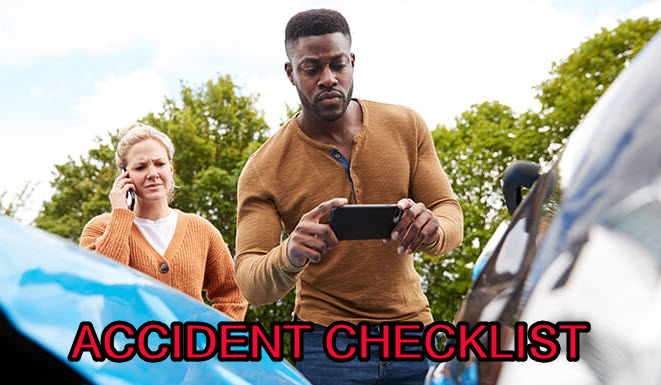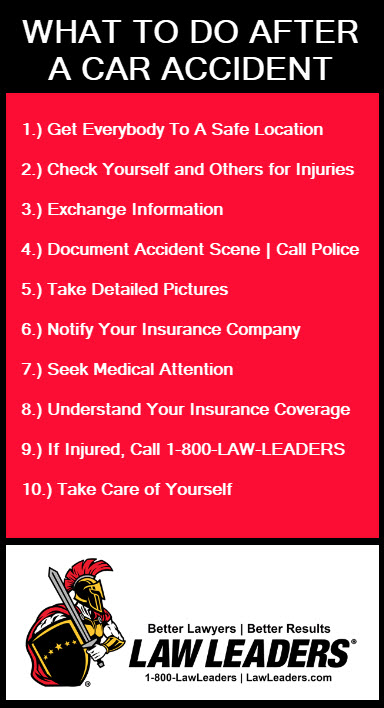
What to do After a Car Accident | When You Get in a Wreck
Posted on April 15, 2024 by Law Leaders

According to the National Highway Traffic Safety Administration (NHTSA), there were approximately 6.7 million police-reported motor vehicle crashes in the United States each year, resulting in over 37,000 deaths and 2.7 million injuries. Given these alarming numbers, it’s crucial to know what steps to take after a car accident to ensure your safety, protect your rights, and navigate the aftermath effectively.
1. Safety First – Get Everybody Involved To Safe Location
In the chaotic moments following a car accident, it’s crucial to prioritize safety above all else. Remaining calm is essential to assess the situation accurately. If possible, move to a safe location away from traffic to avoid the risk of secondary accidents. Turn on hazard lights to alert other drivers of the accident scene. Once in a safe location, check yourself and others for injuries. If your car is safe to drive and may be causing a hazard where it is located, pull over to the side of the road. Otherwise, leave your car where it is and get yourself and others to safety.
2. Check Yourself and Others for Injuries
Checking yourself and others for injuries at the scene of a car accident is a critical step that should be prioritized immediately following the automobile accident . In the chaotic aftermath of a car crash, it’s easy to become overwhelmed, but taking a moment to assess everyone’s well-being can make a significant difference in ensuring prompt medical attention and preventing further harm.
Take a deep breath and focus on assessing yourself for any signs of injury. Check for pain, discomfort, or any unusual sensations, even if they seem minor at first. Some injuries, such as whiplash or internal trauma, may not be immediately apparent but can worsen over time if left untreated. Pay close attention to areas of your body that may have absorbed the impact of the collision, such as your head, neck, chest, and limbs.
Next, turn your attention to any passengers in your vehicle. Check on their well-being and ask if they are experiencing any pain or discomfort. Encourage them to remain calm and still while you assess their injuries. If anyone complains of pain or exhibits signs of injury, such as bleeding, bruising, or difficulty moving, err on the side of caution and seek medical attention promptly.
After assessing the occupants of your vehicle, turn your attention to individuals in other vehicles involved in the accident. Approach them calmly and inquire about their well-being. Offer assistance if needed, but be mindful of your own safety and the safety of others. If someone appears to be seriously injured or unconscious, refrain from moving them unless it’s absolutely necessary to prevent further harm. Instead, call emergency services immediately and follow their instructions while waiting for help to arrive.
In addition to checking for visible injuries, be alert to signs of potential internal injuries or medical emergencies. Look for symptoms such as dizziness, nausea, confusion, difficulty breathing, or loss of consciousness. If you or anyone else exhibits these symptoms, prioritize seeking medical attention without delay.
Remember that even if you don’t notice any immediate signs of injury, it’s still advisable to seek medical evaluation as soon as possible. Some injuries may not manifest symptoms until hours or days after the accident, and early intervention can prevent complications and promote a faster recovery.
3. Exchange Information Including Auto Insurance Policy Information
After ensuring safety, the next step is to exchange information with the other driver(s) involved in the accident. This information exchange is crucial for insurance claims and legal purposes. Exchange contact information, including names, addresses, phone numbers, and insurance policy details. Additionally, gather contact information from any witnesses to the accident who may provide valuable testimony if needed. Accurate information exchange lays the foundation for a smoother claims process and helps resolve any potential disputes that may arise following the accident.
4. Document The Auto Accident Scene Details | Call The Police
Documenting the accident scene is essential for insurance claims and legal proceedings. Use your smartphone or a camera to take photos of the accident scene from multiple angles, including damages to vehicles, road conditions, traffic signs, and any other relevant details. If possible, sketch a diagram of the accident scene, noting the positions of vehicles and any contributing factors. If the accident is severe or involves significant damages or injuries, it’s advisable to contact law enforcement and file a police report. A police accident report provides an official record of the accident, which can strengthen your insurance claim and protect your legal interests. Official documentation and accident checklist should include the following items:
- Name and contact information of each driver involved
 Auto Insurance company and policy number
Auto Insurance company and policy number- Driver’s license and license plate number of each automobile involved
- Type, color and model of vehicle/s involved
- Physical location of accident
- The name and contact information of any witness to the accident
- What auto repair shop your car is being sent from the tow truck driver or police officer (if your car is towed from an accident)
5. Take Detailed Pictures from the Accident Scene
Taking pictures at the scene of a car accident is not just a recommended step; it’s a crucial aspect of documenting the incident for insurance claims and legal purposes. These photographs serve as tangible evidence of the events that unfolded, providing valuable insights into the severity of damages, injuries sustained, and contributing factors to the accident. Most everybody today has a smart phone with them capable of taking many pictures so when in doubt, take as many pictures as possible. In addition to the crash scene, it is also a good idea to take pictures of license plates, driver licenses, proof of insurance cards, and anything else that needs to be documented down.
When taking pictures at the scene of a car accident, it’s essential to adopt a systematic approach to ensure all important details are captured. One of the most crucial aspects is to take pictures from multiple angles. This means capturing all sides of the vehicles involved in the accident to provide a comprehensive view of the vehicle damages. Make sure your photos encompass all four corners of each car, as damages may not be limited to just one area.
Furthermore, it’s crucial to photograph the damage sustained by the vehicles and any leaking fluids. These images not only document the extent of damages but also provide evidence of any hazardous conditions resulting from the accident. Additionally, giving the pictures a sense of scale is vital to accurately convey the severity of damages. Utilize objects like coins or keys to provide a reference point for the size of dents or scrape marks on the vehicles.
Taking pictures from more than one distance offers a nuanced perspective of the accident scene. Start by standing at least 10 feet away from the vehicles and gradually move closer to capture details as you approach the point of collision. This approach helps in capturing the overall context of the accident while also focusing on specific areas of interest, such as skid marks or gouge marks on the pavement.
In addition to taking pictures of the vehicles and immediate surroundings, it’s essential to photograph the surrounding area. Capture images of the street, including any relevant street signs or traffic signals, especially if the accident occurred at an intersection. Skid marks or gouge marks left on the pavement or dirt can provide valuable insights into the dynamics of the accident.
Moreover, documenting any vehicle damage to the car’s interior, such as deployed airbags or shattered glass, is crucial for accurately assessing the extent of damages and potential injuries. Similarly, taking pictures of any injuries sustained by occupants, including scrapes, cuts, or bruises, serves as crucial evidence for injury claims.
Lastly, capturing images of any other items that help tell the story of the accident is essential. This may include objects in the road that contributed to the accident, property damage, mile markings, such as potholes, road construction, or debris that caused a driver to swerve. These images provide additional context and support your account of the events leading up to the collision.
6. Notify Your Insurance Company
Promptly notifying your insurance company about the accident is critical to initiating the insurance claim process. Most insurance policies require policyholders to report accidents within a specified timeframe, typically within 24 to 48 hours. Failure to report the accident promptly may result in complications with the claims process and potential denial of coverage. When reporting the accident to your insurance company, provide accurate and detailed information about the incident, including the date, time, location, and a description of what happened. Be prepared to provide the contact information of the other driver(s) involved and any witnesses.
7. Seek Medical Attention
Even if you don’t feel injured immediately after the accident, it’s essential to seek medical treatment promptly. Some injuries, such as whiplash or internal injuries, may not manifest symptoms until hours or days later. By seeking medical assistance promptly, you can ensure that any injuries are diagnosed and treated promptly, preventing further complications. Follow your doctor’s recommendations for treatment and follow-up care, and keep detailed records of all medical bills and expenses and treatments received. These medical records will be essential for documenting your injuries and expenses during the insurance claims process.
8. Understand Your Insurance Coverage
Reviewing your insurance policy to understand your coverage, deductibles, and limits is essential after a car accident. Understanding your insurance coverage can help you make informed decisions during the claims process and avoid surprises later on. Pay attention to details such as liability coverage, collision coverage, uninsured/underinsured motorist coverage, and medical payments coverage. Be aware of any deductibles that apply to your policy and any limits on coverage. If you have questions about your insurance coverage or the claims process, don’t hesitate to contact your insurance company or agent for clarification.
9. Consider Legal Representation From an Experienced Car Accident Lawyer
In cases involving injuries, disputed liability, or complex legal issues, it may be advisable to seek legal representation from an experienced auto accident attorney to start a claim for compensation. A skilled auto accident attorney can advocate on your behalf, protect your legal rights, and help you navigate the complexities of the legal system and help handle any potential claims. Statistics show that accident victims who hire legal representation often receive higher settlements than those who handle their claims independently. Additionally, an attorney can handle negotiations with insurance companies, gather evidence to support your claim, and, if necessary, represent you in court. Call 1-800-Law-Leaders (1-800-529-5323) now to speak to a top rated car accident lawyer in your area for FREE now.
10. Take Care of Yourself
Dealing with the aftermath of a car accident can be stressful and overwhelming, both physically and emotionally. It’s essential to prioritize your well-being during this challenging time. Reach out to friends, family, or a therapist for support if needed. Practice self-care strategies such as getting rest, eating nutritious foods, and engaging in activities that bring you comfort and relaxation. If you’re experiencing symptoms of post-traumatic stress disorder (PTSD) or other mental health issues following the accident, don’t hesitate to seek professional help. Taking care of yourself will not only promote your recovery but also help you navigate the aftermath of the accident more effectively.
Car accidents are a common occurrence with potentially serious consequences. By knowing what steps to take after an auto accident, you can protect yourself, your rights, and your well-being. Prioritize safety, document the incident, seek medical and legal assistance as needed, and take care of yourself during the recovery process. Remember that you’re not alone, and support is available to help you through this challenging time. Call 1-800-Law-Leaders (1-800-529-5323) now to speak to a top rated car accident lawyer in your area for FREE now.
Leave a Reply
You must be logged in to post a comment.
 1-800-LAW-Leaders (529-5323)
1-800-LAW-Leaders (529-5323)